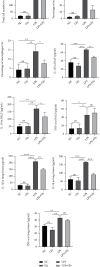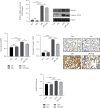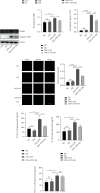Glibenclamide Alleviates LPS-Induced Acute Lung Injury through NLRP3 Inflammasome Signaling Pathway
- PMID: 35185385
- PMCID: PMC8856806
- DOI: 10.1155/2022/8457010
Glibenclamide Alleviates LPS-Induced Acute Lung Injury through NLRP3 Inflammasome Signaling Pathway
Abstract
Glibenclamide displays an anti-inflammatory response in various pulmonary diseases, but its exact role in lipopolysaccharide- (LPS-) induced acute lung injury (ALI) or acute respiratory distress syndrome (ARDS) remains unknown. Herein, we aimed to explore the effect of glibenclamide in vivo and in vitro on the development of LPS-induced ALI in a mouse model. LPS stimulation resulted in increases in lung injury score, wet/dry ratio, and capillary permeability in lungs, as well as in total protein concentration, inflammatory cells, and inflammatory cytokines including IL-1β, IL-18 in bronchoalveolar lavage fluid (BALF), and lung tissues, whereas glibenclamide treatment reduced these changes. Meanwhile, the increased proteins of NLRP3 and Caspase-1/p20 after LPS instillation in lungs were downregulated by glibenclamide. Similarly, in vitro experiments also found that glibenclamide administration inhibited the LPS-induced upregulations in cytokine secretions of IL-1β and IL-18, as well as in the expression of components in NLRP3 inflammasome in mouse peritoneal macrophages. Of note, glibenclamide had no effect on the secretion of TNF-α in vivo nor in vitro, implicating that its anti-inflammatory effect is relatively specific to NLRP3 inflammasome. In conclusion, glibenclamide alleviates the development of LPS-induced ALI in a mouse model via inhibiting the NLRP3/Caspase-1/IL-1β signaling pathway, which might provide a new strategy for the treatment of LPS-induced ALI.
Copyright © 2022 Jie Yang et al.
Conflict of interest statement
There was no competing interest to declare.
Figures





Similar articles
-
Pirfenidone ameliorates lipopolysaccharide-induced pulmonary inflammation and fibrosis by blocking NLRP3 inflammasome activation.Mol Immunol. 2018 Jul;99:134-144. doi: 10.1016/j.molimm.2018.05.003. Epub 2018 May 26. Mol Immunol. 2018. PMID: 29783158
-
Dynasore Alleviates LPS-Induced Acute Lung Injury by Inhibiting NLRP3 Inflammasome-Mediated Pyroptosis.Drug Des Devel Ther. 2024 Apr 23;18:1369-1384. doi: 10.2147/DDDT.S444408. eCollection 2024. Drug Des Devel Ther. 2024. PMID: 38681210 Free PMC article.
-
Glibenclamide alleviates inflammation in oleic acid model of acute lung injury through NLRP3 inflammasome signaling pathway.Drug Des Devel Ther. 2019 May 7;13:1545-1554. doi: 10.2147/DDDT.S196040. eCollection 2019. Drug Des Devel Ther. 2019. PMID: 31123394 Free PMC article.
-
Acute Lung Injury and the NLRP3 Inflammasome.J Inflamm Res. 2024 Jun 13;17:3801-3813. doi: 10.2147/JIR.S464838. eCollection 2024. J Inflamm Res. 2024. PMID: 38887753 Free PMC article. Review.
-
Targeting of neuroinflammation by glibenclamide in Covid-19: old weapon from arsenal.Inflammopharmacology. 2023 Feb;31(1):1-7. doi: 10.1007/s10787-022-01087-8. Epub 2022 Nov 23. Inflammopharmacology. 2023. PMID: 36418600 Free PMC article. Review.
Cited by
-
Glibenclamide-Loaded Nanoparticles Reduce NLRP3 Inflammasome Activation and Modulate miR-223-3p/miR-7-1-5p Expression in THP-1 Cells.Pharmaceuticals (Basel). 2023 Nov 10;16(11):1590. doi: 10.3390/ph16111590. Pharmaceuticals (Basel). 2023. PMID: 38004455 Free PMC article.
-
The key players of inflammasomes and pyroptosis in sepsis-induced pathogenesis and organ dysfunction.Front Pharmacol. 2025 May 19;16:1586364. doi: 10.3389/fphar.2025.1586364. eCollection 2025. Front Pharmacol. 2025. PMID: 40458798 Free PMC article. Review.
-
Gas6 induces AIM to suppress acute lung injury in mice by inhibiting NLRP3 inflammasome activation and inducing autophagy.Front Immunol. 2025 Feb 17;16:1523166. doi: 10.3389/fimmu.2025.1523166. eCollection 2025. Front Immunol. 2025. PMID: 40034700 Free PMC article.
-
Advances in acute respiratory distress syndrome: focusing on heterogeneity, pathophysiology, and therapeutic strategies.Signal Transduct Target Ther. 2025 Mar 7;10(1):75. doi: 10.1038/s41392-025-02127-9. Signal Transduct Target Ther. 2025. PMID: 40050633 Free PMC article. Review.
-
Glibenclamide Serves as a Potent Vasopressor to Treat Vasoplegia After Cardiopulmonary Bypass and Reperfusion in a Porcine Model.Int J Mol Sci. 2025 Apr 24;26(9):4040. doi: 10.3390/ijms26094040. Int J Mol Sci. 2025. PMID: 40362279 Free PMC article.
References
-
- Villar J., Sulemanji D., Kacmarek R. M. The acute respiratory distress syndrome: incidence and mortality, has it changed? Current Opinion in Critical Care . 2014;20(1):3–9. - PubMed
-
- Thompson B. T., Chambers R. C., Liu K. D. Acute respiratory distress syndrome. The New England Journal of Medicine . 2017;377(6):562–572. - PubMed
-
- Fanelli V., Ranieri V. M. Mechanisms and clinical consequences of acute lung injury. Annals of the American Thoracic Society . 2015;12(Supplement 1):S3–S8. - PubMed
MeSH terms
Substances
LinkOut - more resources
Full Text Sources
Other Literature Sources
Miscellaneous

